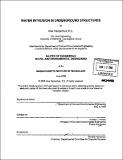Water intrusion in underground structures
Author(s)
Nazarchuk, Alex
DownloadFull printable version (38.65Mb)
Other Contributors
Massachusetts Institute of Technology. Dept. of Civil and Environmental Engineering.
Advisor
Andrew J. Whittle.
Terms of use
Metadata
Show full item recordAbstract
This thesis presents a study of the permissible groundwater infiltration rates in underground structures, the consequences of this leakage and the effectiveness of mitigation measures. Design guides and codes do not restrict, address or make clear recommendations for permissible inflows in underground space. Owners, with the help of engineers, typically make decisions based on costs or specifications from past projects without looking at consequences of excessive groundwater infiltration and mitigation costs. The Author has reviewed the published leakage rates for tunnels in comparison with current international standards. After examining over one-hundred case studies, the Author infers that water leakage is the principal damage causing degradation on tunnel linings. International standards for permissible leakage rates (transit tunnels) are consistent with class A definitions of CIRIA (1979) and are approximately 0.1-2 gpm/100,000 SF (0.05-1.2 Uday/SM). The most common cause of leakage (based on numerous case studies) in cast-in-place lining is due to cracks that develop from shrinkage of concrete during curing and to the inability of the structure to accommodate movements due to thermal changes. Individual sources of leakage may be allowable within the permissible rates, however can cause damage to tunnel structure and to the surrounding environment (consolidation and differential settlement). Spalling is one of most common structural damages due to groundwater infiltration. The presence of water can cause unpleasant stains, resulting in erosion and corrosion over time. Formation of icicles, ice and water ponding can affect public safety in a tunnel and jeopardize operations. To mitigate leakage in underground structures and tunnels one may control and/or eliminate the inflow. (cont.) Chemical grouting is one of the most common measures. However, its application has been unsuccessful in 43% of cases reported by ITA-AITES (2001). Inappropriate material selection for each particular application is major contributing factor for the lack of success. The Author focused this thesis on highway and rail tunnels, and established recommended permissible leakage rates for such underground structures based on international standards and experiences. These recommended rates can serve as guidelines for future tunnel design specifications or to compare recorded inflow rates with international standards.
Description
Thesis (M. Eng.)--Massachusetts Institute of Technology, Dept. of Civil and Environmental Engineering, 2008. Includes bibliographical references (p. 119-124).
Date issued
2008Department
Massachusetts Institute of Technology. Department of Civil and Environmental EngineeringPublisher
Massachusetts Institute of Technology
Keywords
Civil and Environmental Engineering.